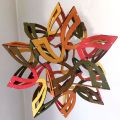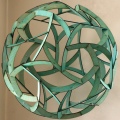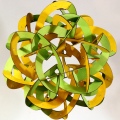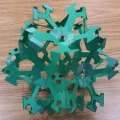
Geometric sculpture showcases the beauty of
mathematics in a permanent way. It captures the essence of
math as a creative artform and makes it inviting and accessible
to the general public. Working as a group on the assembly
of a sculpture becomes a metaphor for the collaborative process
of solving mathematical problems. Professional
mathematicians often take great pleasure in working together to
solve challenging puzzles. The following sculpture
activities immerse students in enjoyable collaborations that
create an emotional connection to mathematics.
Sculpture differs from other art forms because it is the most
tangible and has a strong physical presence. Many
sculptors encourage their audiences to touch the work in order
to understand it at a more fundamental level. Geometric
sculpture allows this deeper interaction, which communicates
mathematical concepts of pattern and structure in a tactile
manner. When students take part in a geometric sculpture
build, they not only gain deeper understanding from the
construction, but they also become personally invested in the
final result. This leads them to take ownership of the
work, to ask meaningful questions, and to explain the process
and ideas to others.
The following four activities provide teachers with templates
and instructions for a progressively more challenging tetraptych
of sculptural ways to make math visible in the classroom.
The four designs can be spread out over the school year
following the four seasons. Each design consists of sixty
identical laser-cut pieces that assemble with cable ties to make
a sculpture 25 inches in diameter. To prepare the parts, you
need access to a laser cutter, plus three of the four require a
sander to bevel edges. In all four cases, the underlying
symmetry relates to the icosahedron and dodecahedron, which
gives students the opportunity to recognize patterns and
discover recurring mathematical ideas. And together, they
make for a beautiful sculptural display. If desired, the
cable ties can be snipped at the end of the year and the parts
can be reassembled by the following class.







